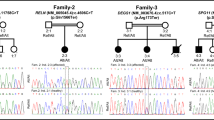Abstract
A recent study has suggested that the A218G polymorphism in the homeobox Al (HOXA1) gene may influence susceptibility to autism. We have determined the frequencies of the A and G alleles of the HOXA1 A218G polymorphism in both white and black patients from the South Carolina Autism Project (SCAP) and controls. Marked differences were found in allele frequencies between the races, but no deviations from Hardy-Weinberg equilibrium were seen in either white or black SCAP family members. More direct tests, comparing genotype frequencies between probands and controls and tracking transmission of the A versus G alleles to affected offspring, did not support the contention that allele status for the HOXA1 A218G polymorphism influences one's susceptibility to autism.
Similar content being viewed by others
References
Bailey, A., Le Couteur, A., & Gottesman, I. (1995). Autism as a strongly genetic disorder: Evidence from a British twin study. Psychological Medicine, 25, 63-77.
Barrett, S., Beck, J. C., & Bernier, R. (1999). An autosomal genomic screen for autism. American Journal of Medical Genetics, 88, 609-615.
Carpenter, E. M., Goddard, J. M., Chisaka, O., Manley, N. R., & Capecchi, M. R. (1993). Loss of Hox-Al (Hox-1.6) function results in the reorganization of the murine hindbrain. Development, 118, 1063-1075.
Chisaka, O., Musci, T. S., & Capecchi, M. R. (1992). Developmental defects of the ear, cranial nerves and hindbrain resulting from targeted disruption of the mouse homebox gene Hox-1.6. Nature, 355, 516-520.
Christianson, A. L., Chesler, N., & Kromberg, J. G. (1994). Fetal valproate syndrome: clinical and neuro-developmental features in two sibling pairs. Developmental Medicine and Child Neurology, 36, 361-369.
Folstein, S. E., & Piven, J. (1991). Etiology of autism: Genetic influences. Pediatrics, 87 (Suppl.), 767-773.
Fombonne, E. (1999). The epidemiology of autism: A review. Psychological Medicine, 29, 769-786.
Ingram, J. L., Stodgell, C. J., & Hyman, S. L. (2000). Discovery of allelic variants of HOXA1 and HOXB1: Genetic susceptibility to autism spectrum disorders. Teratology, 62, 393-405.
International Molecular Genetic Study of Autism Consortium. (1998). Afull genome screen for autism with evidence for linkage to a region on chromosome 7q. Human Molecular Genetics, 7, 571-578.
Johnson, R. T., Toji, L. H., Mars, A., Beiswanger, C. M., Leonard, J. C., Bender, P. K., et al. (2001). Coriell Autism Research Resource: Multiplex familes and their Hoxal plymorphism status. American Journal of Human Genetics, 69, A2208.
Klin, A. (1993). Auditory brainstem responses in autism: Brainstem dysfunction or peripheral hearing loss? Journal of Autism and Developmental Disorders, 23, 1-35.
Li, J., Tabor, H. K., Nguyen, L., Gleason, C., & Lotspeich, L. J. (2001). Lack of association between HoxA1, HoxB1, reelin and WNT-2 gene variants and autism in 110 multiplex families. American Journal of Human Genetics, 69, A2317.
Lord, C., Rutter, M., & Le Couteur, A. (1994). Autism Diagnostic Interview Revised: A revised version of a diagnostic interview for caregivers of individuals with possible pervasive developmental disorders. Journal of Autism and Developmental Disorders, 24, 659-685.
Lotspeich, L. J., & Ciaranello, R. D. (1993). The neurobiology and genetics of infantile autism. International Review of Neurobiology, 35, 87-129.
Mark, M., Lufkin, T., Vonesch, J.-L., Ruberte, E., Olivo, J. C., Dolle, P., et al. (1993). Two rhombomeres are altered in Hoxa-1 mutant mice. Development, 119, 319-338.
Philippe, A., Martinez, M., & Guilloud-Bataille, M. (1999). Genomewide scan for autism susceptibility genes. Human Molecular Genetics, 8, 805-812.
Risch, N., Spiker, D., & Lotspeich, L. (1999). A genomic screen of autism: Evidence for a multilocus etiology. American Journal of Human Genetics, 65, 493-507.
Rodier, P. M., Bryson, S. E., & Welch, J. P. (1997). Minor physical anomalies and physical measurements in autism: Data from Nova Scotia. Teratology, 59, 319-325.
Rodier, P. M., Ingram, J. L., Tisdale, B., Nelson, S., & Romano, J. (1996). Embryological origin for autism: Developmental anomalies of the cranial nerve motor nuclei. Journal of Comparative Neurology, 370, 247-261.
Rosenhall, U., Johansson, E., & Gillberg, C. (1988). Oculomotor findings in autistic children. Journal of Laryngology and Otology, 102, 43-439.
Rutter, M., Silberg, J., & O'Connor, T. (1999). Genetics and child psychiatry: II. Empirical research findings. Journal of Child Psychology and Psychiatry, 40, 19-55.
Schopler, E., Reichler, R. J., DeVellis, R. F., & Daly, K. (1980). Toward objective classification of childhood autism: Childhood Autism Rating Scale (CARS). Journal of Autism and Developmental Disorders, 10, 91-103.
Schroer, R. J., Phelan, M. C., Michaelis, R., Crawford, E. C., Skinner, S. A., Cuccaro, M., et al. (1998). Autism and maternally derived aberrations of chromosome 15q. American Journal of Medical Genetics, 76, 327-336.
Spielman, R., McGinnis, R., & Ewens, W. (1993). Transmission tests for linkage disequilibrium: The insulin gene and insulindependent diabetes mellitus (IDDM). American Journal of Human Genetics, 52, 502-516.
Stodgell, C. J., Gnall, S., & Rodier, P. (2001). Valproic acid exposure alters gene expression in rat embryos: Mechanism of teratogenicity and relationship to autism spectrum disorders. Journal of Human Genetics, 69, A2370.
Strömland, K., Nordin, V., Miller, M., Akerstrom, B., & Gillberg, C. (1994). Autism in thalidomide embryopathy: A population study. Developmental Medicine and Child Neurology, 36, 35-356.
Talebizadeh, Z., Bittel, D. C., Miles, J. H., & Butler, M. G. (2001). Screening of the HOXA1 and HOXB1 genes in a group of autism subjects. American Journal of Human Genetics, 69, A1184.
Walker, H. A. (1977). Incidence of minor physical anomaly in autism. Journal of Autism and Childhood Schizophrenia, 7, 16-176.
Williams, P. G., & Hersh, J. H. (1997). A male with fetal valproate syndrome and autism. Developmental Medicine and Child Neurology, 39, 632-634.
Author information
Authors and Affiliations
Corresponding author
Rights and permissions
About this article
Cite this article
Collins, J.S., Schroer, R.J., Bird, J. et al. The HOXA1 A218G Polymorphism and Autism: Lack of Association in White and Black Patients from the South Carolina Autism Project. J Autism Dev Disord 33, 343–348 (2003). https://doi.org/10.1023/A:1024414803151
Issue Date:
DOI: https://doi.org/10.1023/A:1024414803151




